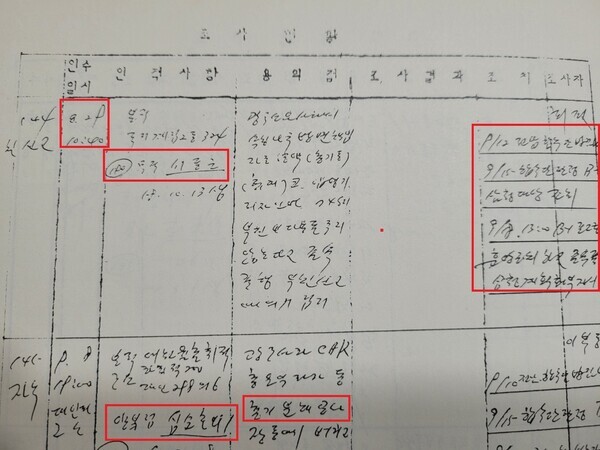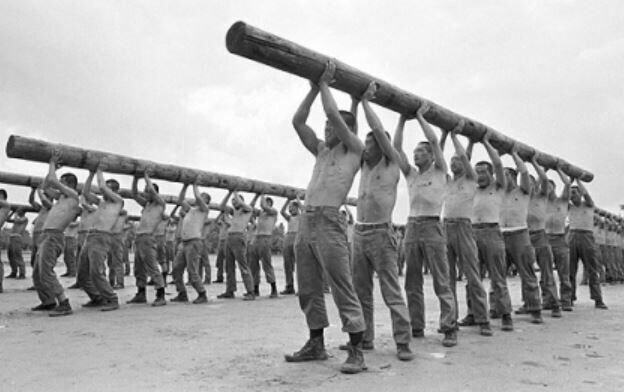hankyoreh
Links to other country sites 다른 나라 사이트 링크
Documents reveal Gwangju Uprising protesters were sent to Samchung Reeducation Camp

Newly discovered documents suggest that the military junta under former South Korean President Chun Doo-hwan misrepresented ordinary protesters in the Gwangju Uprising as violent gangsters and sent them to the notoriously brutal Samchung Reeducation Camp. Some of the protesters at the Samchung camp even ended up at Cheongsong Prison in North Gyeongsang Province.
The discovery has prompted calls for an investigation into whether the junta made a coordinated effort to detain Gwangju protesters at the camp.
Hankyoreh confirmed Monday that 43 people from Gwangju and South Jeolla Province who are officially recognized by the government for their participation in the Gwangju Uprising were sent to the Samchung Reeducation Camp following the uprising which began on May 18, 1980.

The police and a joint team for South Jeolla Province in charge of investigating the uprising framed protesters as gun owners or violent criminals to justify sending them to the Samchung camp. This information appears in messages between the Gwangju police and the South Jeolla Province team of investigators that the Hankyoreh acquired.
In August 1980, Chun’s junta carried out Samchung Plan No. 5, nominally aimed at rounding up gangsters. Under that plan, 39,742 people were detained at the Samchung Reeducation Camp. The detainees including people accused of slandering Chun or spreading false rumors about the Gwangju Uprising and other matters.
Detainees were placed into four categories, ranked from A to D. Those in the A group were sent to prison, while those in the D group were let off with a warning. But those in the B and C groups were sent to 25 military units around the country for four weeks of reeducation.
Some of the participants in the Gwangju Uprising who were taken to the Samchung camp for reeducation were then transferred to Cheongsong Prison, in North Gyeongsang Province, ostensibly out of concerns about recidivism.
A Gwangju resident surnamed Gi (born in 1959) was taken to the Samchung Reeducation Camp because he’d taken part in a protest during the Gwangju Uprising. Gi was severely beaten by government troops during a protest on May 22. On a trip to Seoul that August, he was brought in for questioning by detectives at the Mapo Police Station.
The detectives accused him of “fleeing” from Gwangju and beat him during five days of detention, demanding to know where he’d hidden his firearm.
On Aug. 12, Gi was sent to the Samchung Reeducation Camp, in Yeoncheon, Gyeonggi Province, for four weeks of ranger training. After that, he was forced to work in government construction projects for six months as part of the camp’s “volunteer detail.”
On Dec. 2, 1981, Gi was transferred to Cheongsong Prison. Following his release on Nov. 16, 1982, he suffered from psychiatric disorders.
A Damyang resident surnamed Seo (born in 1959) was arrested at the Gwangju Eastern Police Station in August 1980 and questioned by national security officers. The police accused him of being a Naju ringleader in the Gwangju Uprising and claimed he’d carried a firearm and avoided his military service.
On Sept. 18, the South Jeolla team of investigators decided not to prosecute Seo and to instead assign him to the junta’s Samchung plan. Suh was duly sent to a military unit in Pocheon, Gyeonggi Province, on Sept. 30 and had to endure horrific conditions at the Samchung Reeducation Camp.

At the end of October, Suh was transferred to another unit in Gyeonggi Province, where he had to work at a bunker. He was finally released and allowed to return home at the end of October 1981.
“An investigation is needed into the human rights violations committed by Chun Doo-hwan’s junta when it set up protesters and other participants in the Gwangju Uprising as rioters and sent them to the Samchung Reeducation Camp,” said Chung Su-man, former chair of an organization for families who lost loved ones during the Gwangju Uprising.
In December 2018, South Korea’s Supreme Court found that Martial Law Order No. 13, which the junta had cited as the grounds for the establishment and operation of the Samchung Reeducation Camp, had been unconstitutional and unlawful in every aspect of its provisions and promulgation.
By Jung Dae-ha, senior staff writer
Please direct comments or questions to [english@hani.co.kr]

Editorial・opinion
![[Editorial] Does Yoon think the Korean public is wrong? [Editorial] Does Yoon think the Korean public is wrong?](https://flexible.img.hani.co.kr/flexible/normal/500/300/imgdb/original/2024/0417/8517133419684774.jpg) [Editorial] Does Yoon think the Korean public is wrong?
[Editorial] Does Yoon think the Korean public is wrong?![[Editorial] As it bolsters its alliance with US, Japan must be accountable for past [Editorial] As it bolsters its alliance with US, Japan must be accountable for past](https://flexible.img.hani.co.kr/flexible/normal/500/300/imgdb/original/2024/0417/6817133413968321.jpg) [Editorial] As it bolsters its alliance with US, Japan must be accountable for past
[Editorial] As it bolsters its alliance with US, Japan must be accountable for past- [Guest essay] Amending the Constitution is Yoon’s key to leaving office in public’s good graces
- [Editorial] 10 years on, lessons of Sewol tragedy must never be forgotten
- [Column] A death blow to Korea’s prosecutor politics
- [Correspondent’s column] The US and the end of Japanese pacifism
- [Guest essay] How Korea turned its trainee doctors into monsters
- [Guest essay] As someone who helped forge Seoul-Moscow ties, their status today troubles me
- [Editorial] Koreans sent a loud and clear message to Yoon
- [Column] In Korea’s midterm elections, it’s time for accountability
Most viewed articles
- 1[Column] The clock is ticking for Korea’s first lady
- 2Samsung barricades office as unionized workers strike for better conditions
- 3[Editorial] When the choice is kids or career, Korea will never overcome birth rate woes
- 4Why Israel isn’t hitting Iran with immediate retaliation
- 5[News analysis] After elections, prosecutorial reform will likely make legislative agenda
- 6[Editorial] Does Yoon think the Korean public is wrong?
- 7S. Korea, Japan reaffirm commitment to strengthening trilateral ties with US
- 8[Editorial] As it bolsters its alliance with US, Japan must be accountable for past
- 9Japan officially says compensation of Korean forced laborers isn’t its responsibility
- 10Faith in the power of memory: Why these teens carry yellow ribbons for Sewol